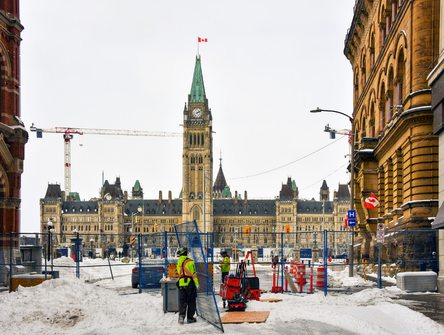A critical milestone on the road to reconciliation
Enshrining the United Nations Declaration on the Rights of Indigenous Peoples in Canadian law could offer a way out of structures established by the Indian Act.
.jpg?ext=.jpg)
When Billy Diamond, grand chief of the Quebec Cree, signed the agreement giving the consent of his people to the James Bay hydro development, he did so reluctantly. "I hope you can all understand our feelings, that it has been a tough fight and our people are still very much opposed to the project, but they realize that they must share the resources," he said in 1977.
Diamond was able to negotiate a land claim agreement, including a $235-million compensation package, because in 1973 the Cree had succeeded in winning an injunction that temporarily stopped bulldozers across northern Quebec.
Diamond had rallied the Cree against the project, which was going to flood their traditional hunting, fishing and trapping territories, and hired Montreal lawyer James O'Reilly to fight it in Quebec Superior Court.
Justice Albert Malouf's historic ruling was overturned on appeal, but the fact that it briefly stopped the project made it clear that the governments of Quebec and Canada could no longer treat the Cree like squatters on the land they had occupied for millennia. A court had recognized the Cree had rights to the territory, and that the land could not be developed without their consent.
Romeo Saganash, who was born in the tiny Cree community of Waswanipi, decided to go to law school after attending a symposium in Montreal on the tenth anniversary of the agreement, and watching the lawyers discuss the deal.
In 1984, Saganash represented the Cree at a United Nations meeting in Geneva where a working group was planning what would eventually become the Declaration on the Rights of Indigenous Peoples (UNDRIP), passed by the UN in 2007.
In 2011, Saganash was elected as an NDP MP for his home riding and twice introduced private member's bills to enshrine UNDRIP into Canadian law. The second one, Bill C-262, died on the order paper when Parliament was prorogued in August 2020.
A few months later, in early December, Justice Minister David Lametti tabled Bill C-15 that would require the government to implement UNDRIP, a long bureaucratic process of reviewing Canadian laws to make sure they align with it.
For Saganash, who retired from politics in 2019, this is the culmination of decades of effort, an important step toward reconciliation.
"In 2004, the Supreme Court said in the Haida Nation case that the objective of reconciliation is to reconcile the preexisting sovereignty of Indigenous peoples with the assumed sovereignty of the Crown," he said. "The United Nations declaration is only one framework among others. You can throw in treaties as a framework. You can throw in Indigenous law. The Constitution, of course, is a framework. Jurisprudence that came down from the Supreme court over the years is also a framework. So all of these frameworks are mutually reinforcing."
The 46 articles of the Declaration, often described as an "aspirational" document painstakingly composed over 40 years, set out principles to allow Indigenous societies to control their destinies while enjoying the benefits of citizenship in their nation states without discrimination or forced assimilation.
Critics of UNDRIP often worry that the document's requirement for "free, prior and informed consent" of Indigenous communities for "any project affecting their lands or territories and other resources" will amount to a veto over economic development projects such as pipelines.
Saganash, who in 2002 negotiated the "Paix des Braves," an updated version of the James Bay agreement, disagrees. "Since 1975, the Cree have signed more than 100 agreements, with the federal government, with the provincial government, with forestry companies, with mining companies, and so on. So, one hundred times they gave their consent with conditions. So free, prior and informed consent as a legal concept is not a veto. It's very different from a veto. A veto is absolute."
Another common concern is that UNDRIP may make it harder to develop projects when hereditary chiefs disapprove, as happened during the winter of 2020 when the Wet'suwet'en hereditary chiefs opposed the Coastal GasLink pipeline in British Columbia despite support from the elected council.
UNDRIP says Indigenous communities have the right to choose their forms of government, which means that traditional systems, like hereditary chieftainships, cannot be ignored. Saganash points to the Cree having decided to form the grand council of the Cree of Quebec (now the Cree Nation Government) to represent them politically. "We didn't choose the traditional form," he said. "That's every nation's business. It's really up to the different nations, but I can't really say anything about how the Wet'suwet'en or the Mi'kmaq deal with governments. That's up to them."
Alisa Lombard, who specializes in aboriginal law with Semaganis Worme Lombard in Saskatoon, says the government may face challenges dealing with competing Indigenous political institutions, but that is a product of structures created by governments during the many decades when they were trying to destroy Indigenous cultures.
"The inconsistencies and governance structures and the competing interests by virtue of the engagement of those different governance structures is of the Crown's making," she said. "And so, yes, it becomes a Crown problem. I don't think that this was envisioned to be a problem because if Crown policy had been successful and that either Indians would have been assimilated or exterminated, which was the very clear purpose. Then there would be nobody here, none of us here to talk about."
Lombard says the ideas in UNDRIP, formally respecting the legitimacy of Indigenous forms of government, offer a way out of the structures established by the Indian Act.
"The Indian Act is not a constitution. It is not organic in any way. It's organic to the Crown. But it makes no sense for Indians. I think that's mainly because Indians aren't really Indians. Indians are Mi'kmaq. They're Wet'suwet'en. They're Kanienkehaka. So this one singular way of doing things in governing oneself, according to Robert's Rules of Order, is simply not the right way."
UNDRIP offers a better way of thinking about the sovereignty of Indigenous communities, she says.
"At the end of the day, the source of the authority is delegated from the Crown and that is really the problem. I mean, you can't build a solid house on a shoddy foundation, right?"
Not all Indigenous people support Bill C-15. Activists like Russ Diabo, who ran against Perry Bellegarde to be National Chief of the Assembly of First Nations in 2018, say the government is subordinating it to Canadian law.
Peter Kulchyski, a native studies professor at the University of Manitoba, is sympathetic to critiques like Diabo's, but he thinks it will provide Indigenous communities with a valuable legal tool.
"There are a fair number of legal resources they can already draw on and they would probably draw on UNDRIP, I have no doubt," he says. But the strength of Indigenous societies ultimately rests on their connection to the land and their traditional culture, he says.
"You can have the best lawyers in the world, but it's your strength on the ground that determines what you're going to get. And that's very much my view after the years I've spent studying Indigenous politics."


